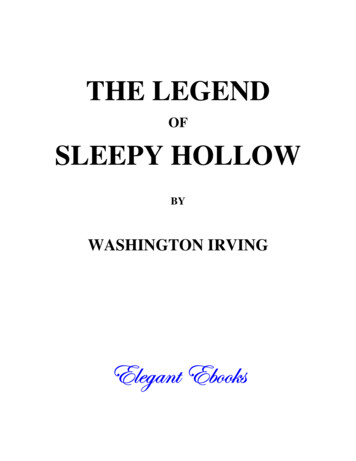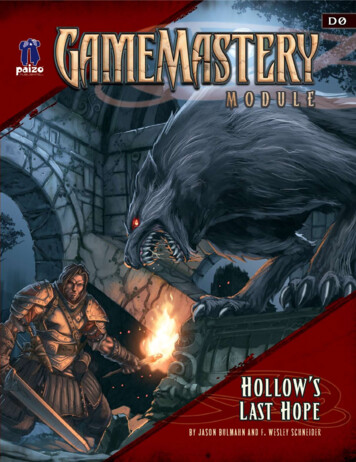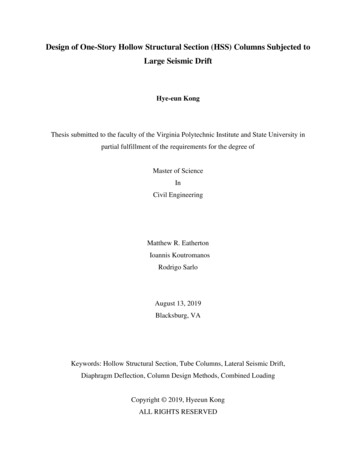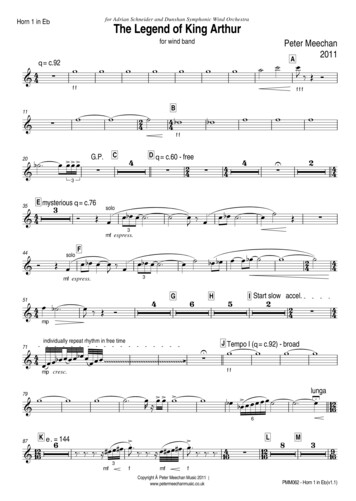
Transcription
THE LEGENDOFSLEEPY HOLLOWBYWASHINGTON IRVING7 WYS f f 77Taa]e
COPYRIGHT INFORMATIONShort Story: “The Legend of Sleepy Hollow”Author: Washington Irving, 1783–1859First published: 1819Illustrations first published: 1863The original story and illustrations are in the public domain in theUnited States and in most, if not all, other countries as well. Readersoutside the United States should check their own countries’ copyright lawsto be certain they can legally download this ebook. The Online Books Pagehas an FAQ which gives a summary of copyright durations for many othercountries, as well as links to more official sources.This PDF ebook wascreated by José Menéndez.NOTE ON THE TEXT“The Legend of Sleepy Hollow” first appeared in Washington Irving’scollection of stories, The Sketch Book of Geoffrey Crayon, Gent.,published in 1819. The text and illustrations used in this ebook are fromthe revised edition of the Sketch Book, published in 1863.
CONTENTSTHE LEGEND OF SLEEPY HOLLOWPOSTSCRIPTLIST OF ILLUSTRATIONSVIEW IN SLEEPY HOLLOW [from sketch by J. H. Hill]ICHABOD’S EVENING WALKKATRINA AT THE WHEELSUNNY SIDEICHABOD AND KATRINATHE MESSENGERTHE TAPPAN ZEECHURCH AT SLEEPY HOLLOW [from sketch by J. H. Hill]THE OLD BRIDGEBROM BONES AND ICHABODVIGNETTE-POSTSCRIPTWM. HARTOERTELLDARLEYWM. HARTHUNTINGTONHOPPINKENSETTWM. HARTT. A. RICHARDSLEUTZEHERRICK
THE LEGEND OF SLEEPY HOLLOW.FOUND AMONG THE PAPERS OF THE LATE DIEDRICHKNICKERBOCKER.“A pleasing land of drowsy head it was,Of dreams that wave before the half-shut eye;And of gay castles in the clouds that pass,Forever flushing round a summer sky.”CASTLE OF INDOLENCE.N the bosom of one of those spacious coveswhich indent the eastern shore of the Hudson, atthat broad expansion of the river denominated bythe ancient Dutch navigators the Tappan Zee,and where they always prudently shortened sail,and implored the protection of St. Nicholas when they crossed, there lies asmall market-town or rural port, which by some is called Greensburgh, but5
6THE LEGEND OF SLEEPY HOLLOWwhich is more generally and properly known by the name of Tarry Town.This name was given, we are told, in former days, by the good housewivesof the adjacent country, from the inveterate propensity of their husbands tolinger about the village tavern on market-days. Be that as it may, I do notvouch for the fact, but merely advert to it, for the sake of being precise andauthentic. Not far from this village, perhaps about two miles, there is alittle valley, or rather lap of land, among high hills, which is one of thequietest places in the whole world. A small brook glides through it, withjust murmur enough to lull one to repose; and the occasional whistle of aquail, or tapping of a woodpecker, is almost the only sound that everbreaks in upon the uniform tranquillity.I recollect that, when a stripling, my first exploit in squirrel-shootingwas in a grove of tall walnut-trees that shades one side of the valley. I hadwandered into it at noon-time, when all nature is peculiarly quiet, and wasstartled by the roar of my own gun, as it broke the Sabbath stillnessaround, and was prolonged and reverberated by the angry echoes. If ever Ishould wish for a retreat, whither I might steal from the world and itsdistractions, and dream quietly away the remnant of a troubled life, I knowof none more promising than this little valley.From the listless repose of the place, and the peculiar character of itsinhabitants, who are descendants from the original Dutch settlers, thissequestered glen has long been known by the name of SLEEPY HOLLOW,and its rustic lads are called the Sleepy Hollow Boys throughout all theneighboring country. A drowsy, dreamy influence seems to hang over theland, and to pervade the very atmosphere. Some say that the place wasbewitched by a high German doctor, during the early days of thesettlement; others, that an old Indian chief, the prophet or wizard of histribe, held his powwows there before the country was discovered byMaster Hendrick Hudson. Certain it is, the place still continues under thesway of some witching power, that holds a spell over the minds of thegood people, causing them to walk in a continual reverie. They are givento all kinds of marvellous beliefs; are subject to trances and visions; andfrequently see strange sights, and hear music and voices in the air. Thewhole neighborhood abounds with local tales, haunted spots, and twilightsuperstitions: stars shoot and meteors glare oftener across the valley than
WASHINGTON IRVING7in any other part of the country, and the nightmare, with her whole ninefold, seems to make it the favorite scene of her gambols.The dominant spirit, however, that haunts this enchanted region, andseems to be commander-in-chief of all the powers of the air, is theapparition of a figure on horseback without a head. It is said by some to bethe ghost of a Hessian trooper, whose head had been carried away by acannon-ball, in some nameless battle during the revolutionary war; andwho is ever and anon seen by the country folk, hurrying along in the gloomof night, as if on the wings of the wind. His haunts are not confined to thevalley, but extend at times to the adjacent roads, and especially to thevicinity of a church at no great distance. Indeed, certain of the mostauthentic historians of those parts, who have been careful in collecting andcollating the floating facts concerning this spectre, allege that the body ofthe trooper having been buried in the churchyard, the ghost rides forth tothe scene of battle in nightly quest of his head; and that the rushing speedwith which he sometimes passes along the Hollow, like a midnight blast, isowing to his being belated, and in a hurry to get back to the churchyardbefore daybreak.Such is the general purport of this legendary superstition, which hasfurnished materials for many a wild story in that region of shadows; andthe spectre is known, at all the country firesides, by the name of theHeadless Horseman of Sleepy Hollow.It is remarkable that the visionary propensity I have mentioned is notconfined to the native inhabitants of the valley, but is unconsciouslyimbibed by every one who resides there for a time. However wide awakethey may have been before they entered that sleepy region, they are sure,in a little while, to inhale the witching influence of the air, and begin togrow imaginative—to dream dreams, and see apparitions.I mention this peaceful spot with all possible laud; for it is in such littleretired Dutch valleys, found here and there embosomed in the great Stateof New York, that population, manners, and customs, remain fixed; whilethe great torrent of migration and improvement, which is making suchincessant changes in other parts of this restless country, sweeps by themunobserved. They are like those little nooks of still water which border arapid stream; where we may see the straw and bubble riding quietly at
8THE LEGEND OF SLEEPY HOLLOWanchor, or slowly revolving in their mimic harbor, undisturbed by the rushof the passing current. Though many years have elapsed since I trod thedrowsy shades of Sleepy Hollow, yet I question whether I should not stillfind the same trees and the same families vegetating in its sheltered bosom.In this by-place of nature, there abode, in a remote period of Americanhistory, that is to say, some thirty years since, a worthy wight of the nameof Ichabod Crane; who sojourned, or, as he expressed it, “tarried,” inSleepy Hollow, for the purpose of instructing the children of the vicinity.He was a native of Connecticut; a State which supplies the Union with
WASHINGTON IRVING9pioneers for the mind as well as for the forest, and sends forth yearly itslegions of frontier woodsmen and country schoolmasters. The cognomenof Crane was not inapplicable to his person. He was tall, but exceedinglylank, with narrow shoulders, long arms and legs, hands that dangled a mileout of his sleeves, feet that might have served for shovels, and his wholeframe most loosely hung together. His head was small, and flat at top, withhuge ears, large green glassy eyes, and a long snipe nose, so that it lookedlike a weather-cock, perched upon his spindle neck, to tell which way thewind blew. To see him striding along the profile of a hill on a windy day,with his clothes bagging and fluttering about him, one might havemistaken him for the genius of famine descending upon the earth, or somescarecrow eloped from a corn-field.His school-house was a low building of one large room, rudelyconstructed of logs; the windows partly glazed, and partly patched withleaves of old copy-books. It was most ingeniously secured at vacant hours,by a withe twisted in the handle of the door, and stakes set against thewindow-shutters; so that, though a thief might get in with perfect ease, hewould find some embarrassment in getting out; an idea most probablyborrowed by the architect, Yost Van Houten, from the mystery of an eelpot. The school-house stood in a rather lonely but pleasant situation, just atthe foot of a woody hill, with a brook running close by, and a formidablebirch-tree growing at one end of it. From hence the low murmur of hispupils’ voices, conning over their lessons, might be heard in a drowsysummer’s day, like the hum of a bee-hive; interrupted now and then by theauthoritative voice of the master, in the tone of menace or command; or,peradventure, by the appalling sound of the birch, as he urged some tardyloiterer along the flowery path of knowledge. Truth to say, he was aconscientious man, and ever bore in mind the golden maxim, “Spare therod and spoil the child.”—Ichabod Crane’s scholars certainly were notspoiled.I would not have it imagined, however, that he was one of those cruelpotentates of the school, who joy in the smart of their subjects; on thecontrary, he administered justice with discrimination rather than severity;taking the burden off the backs of the weak, and laying it on those of thestrong. Your mere puny stripling, that winced at the least flourish of the
10THE LEGEND OF SLEEPY HOLLOWrod, was passed by with indulgence; but the claims of justice were satisfiedby inflicting a double portion on some little, tough, wrong-headed, broadskirted Dutch urchin, who sulked and swelled, and grew dogged and sullenbeneath the birch. All this he called “doing his duty by their parents;” andhe never inflicted a chastisement without following it by the assurance, soconsolatory to the smarting urchin, that “he would remember it, and thankhim for it the longest day he had to live.”When school hours were over, he was even the companion andplaymate of the larger boys; and on holiday afternoons would convoysome of the smaller ones home, who happened to have pretty sisters, orgood housewives for mothers, noted for the comforts of the cupboard.Indeed, it behooved him to keep on good terms with his pupils. Therevenue arising from his school was small, and would have been scarcelysufficient to furnish him with daily bread, for he was a huge feeder, and,though lank, had the dilating powers of an anaconda; but to help out hismaintenance, he was, according to country custom in those parts, boardedand lodged at the houses of the farmers, whose children he instructed.With these he lived successively a week at a time; thus going the rounds ofthe neighborhood, with all his worldly effects tied up in a cottonhandkerchief.That all this might not be too onerous on the purses of his rusticpatrons, who are apt to consider the cost of schooling a grievous burden,and schoolmasters as mere drones, he had various ways of renderinghimself both useful and agreeable. He assisted the farmers occasionally inthe lighter labors of their farms; helped to make hay; mended the fences;took the horses to water; drove the cows from pasture; and cut wood forthe winter fire. He laid aside, too, all the dominant dignity and absolutesway with which he lorded it in his little empire, the school, and becamewonderfully gentle and ingratiating. He found favor in the eyes of themothers, by petting the children, particularly the youngest; and like thelion bold, which whilom so magnanimously the lamb did hold, he wouldsit with a child on one knee, and rock a cradle with his foot for wholehours together.In addition to his other vocations, he was the singing-master of theneighborhood, and picked up many bright shillings by instructing the
WASHINGTON IRVING11young folks in psalmody. It was a matter of no little vanity to him, onSundays, to take his station in front of the church gallery, with a band ofchosen singers; where, in his own mind, he completely carried away thepalm from the parson. Certain it is, his voice resounded far above all therest of the congregation; and there are peculiar quavers still to be heard inthat church, and which may even be heard half a mile off, quite to theopposite side of the mill-pond, on a still Sunday morning, which are said tobe legitimately descended from the nose of Ichabod Crane. Thus, by diverslittle make-shifts in that ingenious way which is commonly denominated“by hook and by crook,” the worthy pedagogue got on tolerably enough,and was thought, by all who understood nothing of the labor of headwork,to have a wonderfully easy life of it.The schoolmaster is generally a man of some importance in the femalecircle of a rural neighborhood; being considered a kind of idlegentlemanlike personage, of vastly superior taste and accomplishments tothe rough country swains, and, indeed, inferior in learning only to theparson. His appearance, therefore, is apt to occasion some little stir at thetea-table of a farm-house, and the addition of a supernumerary dish ofcakes or sweetmeats, or, peradventure, the parade of a silver teapot. Ourman of letters, therefore, was peculiarly happy in the smiles of all thecountry damsels. How he would figure among them in the churchyard,between services on Sundays! gathering grapes for them from the wildvines tha
The Online Books Page has an FAQ which gives a summary of copyright durations for many other countries, as well as links to more official sources. This PDF ebook was created by José Menéndez. NOTE ON THE TEXT “The Legend of Sleepy Hollow” first appeared in Washington Irving’s collection of stories, The Sketch Book of Geoffrey Crayon, Gent., published in 1819. The text and illustrations .











